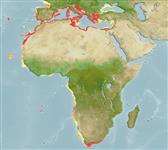Common names from other countries
>
Eupercaria/misc (Various families in series Eupercaria) >
Sparidae (Porgies)
Etymology: Diplodus: Greek, diploos = twice + Greek, odous = teeth (Ref. 45335).
Environment: milieu / climate zone / depth range / distribution range
Ecología
marino bentopelágico; oceanodromo (Ref. 51243); rango de profundidad 0 - 160 m, usually 0 - 30 m (Ref. 13780). Subtropical; ? - 25°C (Ref. 130592); 50°N - 40°S, 26°W - 36°E
Eastern Atlantic: Bay of Biscay to Cape Verde and the Canary Islands including the Mediterranean and Black Sea (off Bulgaria); also from Angola to South Africa.
Length at first maturity / Tamaño / Peso / Age
Maturity: Lm 16.6 range ? - ? cm
Max length : 45.0 cm TL macho / no sexado; (Ref. 3397); common length : 22.0 cm TL macho / no sexado; (Ref. 3397); peso máximo publicado: 1.3 kg (Ref. 40637)
A euryhaline species inhabiting rocky and sometimes sandy bottoms to depths of 160 m, but more commonly in less than 50 m. The young are sometimes found in seagrass beds. Adults feed on crustaceans, worms and mollusks (Ref. 3688). Important food fish.
Potentially hermaphroditic (Ref. 4781).
Bauchot, M.-L. and J.-C. Hureau, 1990. Sparidae. p. 790-812. In J.C. Quero, J.C. Hureau, C. Karrer, A. Post and L. Saldanha (eds.) Check-list of the fishes of the eastern tropical Atlantic (CLOFETA). JNICT, Lisbon; SEI, Paris; and UNESCO, Paris. Vol. 2. (Ref. 3688)
IUCN Red List Status (Ref. 130435)
CITES (Ref. 128078)
Not Evaluated
Threat to humans
Harmless
Human uses
Pesquerías: comercial; pesca deportiva: si; Acuario: Comercial
Herramientas
Special reports
Download XML
Fuentes de Internet
Estimates based on models
Preferred temperature (Ref.
115969): 15.9 - 21.6, mean 18.8 (based on 248 cells).
Phylogenetic diversity index (Ref.
82804): PD
50 = 0.5000 [Uniqueness, from 0.5 = low to 2.0 = high].
Bayesian length-weight: a=0.01230 (0.01097 - 0.01380), b=3.05 (3.02 - 3.08), in cm Total Length, based on LWR estimates for this species (Ref.
93245).
Nivel trófico (Ref.
69278): 3.5 ±0.1 se; based on diet studies.
Resiliencia (Ref.
120179): Medio, población duplicada en un tiempo mínimo de 1.4-4.4 años (K=0.26-0.4; tmax=6; tm=2).
Fishing Vulnerability (Ref.
59153): Low to moderate vulnerability (33 of 100).
Climate Vulnerability (Ref.
125649): Low vulnerability (23 of 100).
